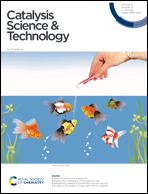Unveiling remarkable resistance to Pb poisoning over an Fe–Mo catalyst for low-temperature NH3-SCR: poison transforms into a promoter†
Abstract
Although lead (Pb) poisoning is a significant issue in the low-temperature selective catalytic reduction of NOx with NH3 (NH3-SCR), the development of an effective Pb-resistant catalyst presents a challenge. Herein, a Fe–Mo catalyst composed of highly dispersed α-Fe2O3 and β-FeMoO4 was designed that exhibits remarkable resistance to Pb poisoning, achieving more than 90% NOx conversion at 225–400 °C (GHSV = 50 000 h−1) even with a Pb content of 20 wt%. More importantly, the poisoned catalysts show higher intrinsic activity and lower apparent activation energy compared to fresh sample. The characterization results indicate that the Pb species is captured by abundant Brønsted acid sites (Mo–OH) to form a PbMoO4 phase, while barely influencing the Lewis acid sites and redox properties of the catalyst. The consumption kinetics of the adsorbed NH3 based on in situ diffuse reflectance infrared Fourier transform spectroscopy (DRIFTS) confirmed that the surface PbMoO4 species effectively boost the activation of the reactants, thus improving the inherent NH3-SCR reactivity through both Langmuir–Hinshelwood and Eley–Rideal pathways, which is the origin of the strong resistance against the high loading of Pb over the Mo–Fe catalyst. This work reveals a novel promotion mechanism of Pb species and provides a way in which to design a Pb-resistant low-temperature NH3-SCR catalyst.



 Please wait while we load your content...
Please wait while we load your content...